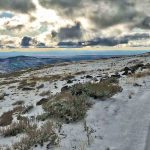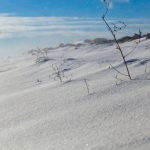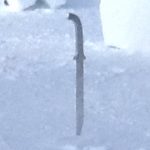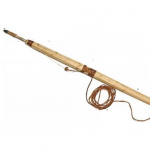Overview
Inuit knowledge of snow is vast and allows using this resource in various crucial activities on the land, such as navigating safely and building shelters. In this lesson, students will deepen their knowledge of snow by learning about density through traditional Inuit and scientific methods.
Outcomes
At the end of this lesson, students will be able to identify at least three types of snow (aqilluqaq, sitilluqaq, pukajaq) by using the panak and to determine their density from samples using the gravitometric method1.
By creating a reference tool and using it to determine the type of a snow sample, students will demonstrate the competency: seeking answers or solutions to scientific or technological problems.
Knowledge
Characteristics of different types of snow (hardness, density)
Skills
Sampling
using a scale
Attitudes
Inquisitiveness
Aim for precision
Flow
1. Types of Snow
Qaujisartuq: the emergent learner is observing and listening
Invite a knowledge holder to demonstrate, on the land, how to identify different types of snow using the panak and to talk about the characteristics and functions of different types of snow. Although there is a multitude of types of snow, we suggest working with the following three.
Soft powdery snow, new snow
Hard compacted snow, old snow
Crystallized snow
Students can then practice finding these three types of snow using the panak and practicing the vocabulary. Further their reflection on the characteristics of these types of snow by asking questions.
- Why do you think it is x type of snow?
- What felt different with the unak when you touched x type of snow?
- What do you notice when you take x type of snow in your hand ?
2. Snow Density
On the land, student should have identified that the three types of snow have different hardness. In the classroom, ask students to hypothesize about why the hardness of different types of snow is different.
Although hardness is not always related to density, it is the case for these three types of snow. To demonstrate this principle, you can use small balls of modelling clay and slowly compress them together.

Source: University of Copenhagen Centre for Ice and Climate
Then explain that density influence weight, still using the modelling clay. Put the fake samples on the scale to demonstrate this principle and insist on the importance of using samples that have the same volume.
Name this principle: density is mass over volume. For snow, it is defined as “the amount or mass of ice and liquid water per volume”2 and is generally described in kg/m3.

Picture by Charlie Nowkawalk
3. Density
Tukisilirtuq: the transitional learner is using a new skill with uncertainty and needs support
Before going on the land to determine the density of three types of snow, students should practice collecting data (mass and volume) and calculating the density.
Start with simple objects that can be compared in size. A cube of wood, a cube of styrofoam and a cube of modelling clay for example.
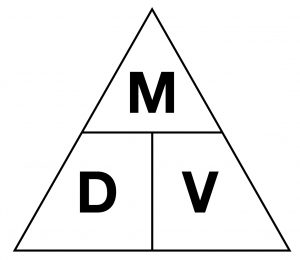
First, students use the scale to weight their objects. Second, they measure all the faces and determine the volume. Third, they divide the mass (g) by the volume (cm3) to obtain the density. For more advanced students, you can include conversions.
4. Snow Density
Tukisinaqsijuq: the communicative learner shows a growing confidence in this familiar situation.
On the land, students use the panak to find three different types of snow. Once they successfully identified aqilluqaq, sitilluqaq and pukajaq, they use the following protocol to calculate snow density.
- Measure the dimensions of the sampling instrument and determine the volume (could be done prior).
- Weight the empty sampling instrument and note the weight.
- Take a snow sample by bushing the tube into snow and pulling it out.
- Weight the full sampling instrument and note the weight.
- Calculate the net weight of the sample.
- Use the formula to calculate the snow sample’s density.
- Repeat for each type of snow and note the results in a table.
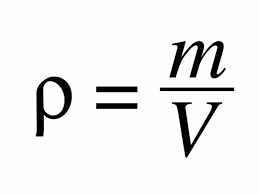
5. Discussion
Tukisinaksijuq: the communicative learner shares about their experience and consider others’ results
In the classroom, discuss and compare the results. Are they close enough to create an average density for each type of snow? Would an interval be more appropriate to represent each type of snow? What can students say about the hardness of the snow and its density?
Assessment
We suggest assessing this lesson by asking students to identify the type of an unknown sample of snow based on its density and the table they created previously. At that point, students might have reached tukisinaksijuq, the communicative stage of learning where they can perform this familiar task and share their results.
All
All students will measure and weigh their sample correctly and use this data in the density formula.
Most
Most students will determine accurately the volume of their sample and withdraw the weigh of the sampling tool to use accurate data in the density formula.
Some
Some students will accurately determine the type of snow of their sample by using precise data and interpreting their results.
Extensions
- Ask students to determine the depth of each layer of snow and to measure the density of samples at different levels.
- Ask students to measure the density of many samples of each type of snow and to determine the average or the range for this type of snow.
- Put the density in relation with more data gathered through the other snow lesson plans.
Vocabulary
- Aqilluqaq (soft powdery snow, fresher snow)
- Sitilluqaq (hard compacted snow, older snow)
- Pukajaq (crystallized snow)
- Unak (harpoon, here used as a probe to feel the snow hardness)
- Panak (snow knife)
References
- Zhang, T., Su, K. & Wang, K. (2017). Comparison of Snow Density Measurements using Different Equipments. First Workshop on NASA SnowEx Results. Denver, Colorado. Document accessible online at: https://snow.nasa.gov/sites/default/files/Zhang_080917_15_Snow%20Density%20Comparison.pdf
- West, G. & Howard, R. (2018). Title. ATSC113 – Weather for Sailing, Flying and Snow Sports. University of British Columbia. Document accessible online at: https://www.eoas.ubc.ca/courses/atsc113/snow/met_concepts/07-met_concepts/07b-newly-fallen-snow-density/


